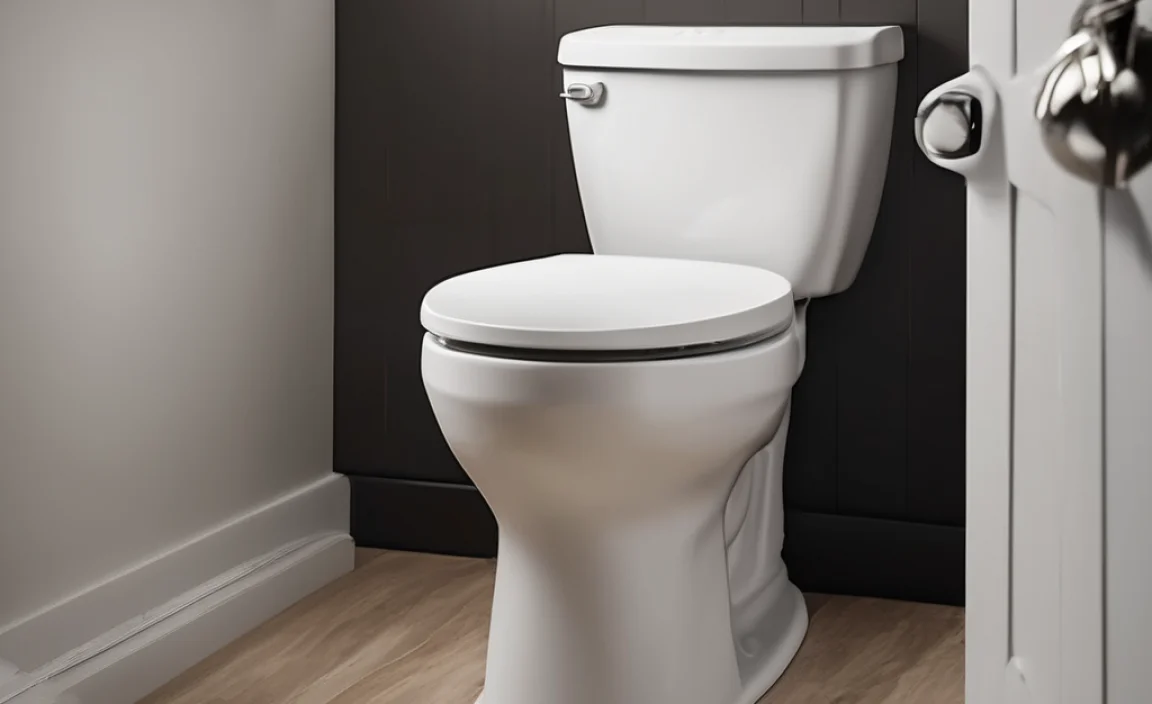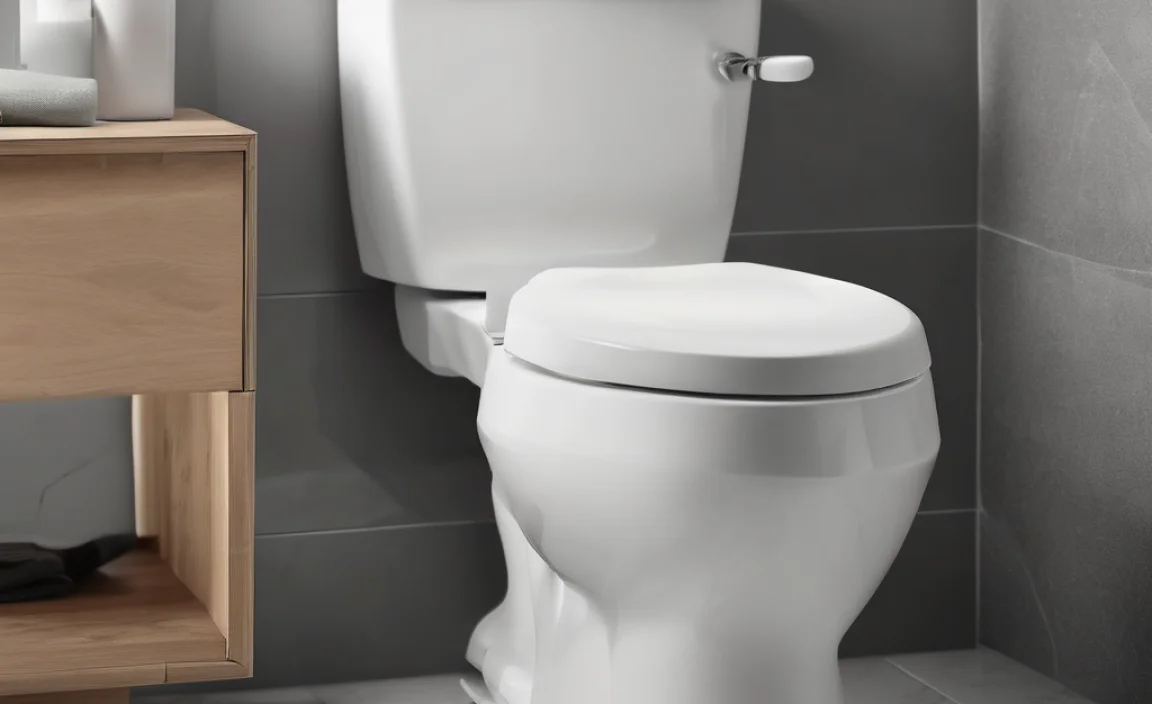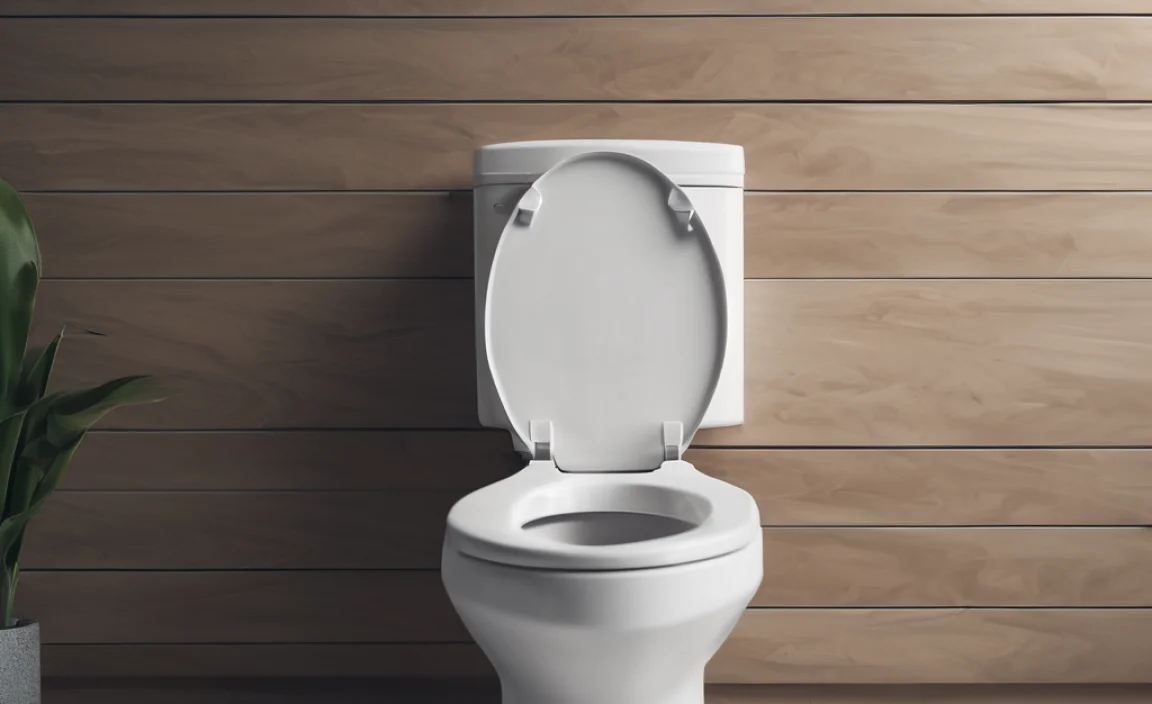That U-shaped gap at the front of many toilet seats? It’s there for hygiene! It makes it easier for women to wipe after using the toilet and helps reduce the risk of germs spreading. The gap also accommodates people of all body types, as required by accessibility standards in public restrooms.
Ever noticed that little gap at the front of a toilet seat? You’re not alone if you’ve wondered why it’s there. It might seem a bit odd or even like a design flaw, but there’s actually a good reason for it. It’s all about hygiene and accessibility. No need to worry, you’re not missing something obvious! This article will break down the reasons for that gap and clear up any confusion. Let’s get started!
The Real Reason Behind the Toilet Seat Gap

That U-shaped gap you see on many public toilet seats isn’t a mistake. It’s a deliberate design feature with several purposes.
Hygiene and Cleanliness
The primary reason for the gap is hygiene. The gap makes it easier to clean the toilet, reducing the buildup of germs and bacteria. It also provides more space for women to wipe, helping to prevent the spread of germs and maintain better hygiene.
- Easier Cleaning: The gap allows for better access when cleaning the toilet bowl and seat.
- Reduced Germ Spread: The open space minimizes contact with potentially contaminated surfaces.
- Improved Hygiene for Women: The design provides more room for wiping and staying clean.
Accessibility and Compliance
Another key reason for the gap is to comply with accessibility standards. The Americans with Disabilities Act (ADA) requires that public toilet seats have this open front design. This helps accommodate people of all body types and makes it easier for individuals with disabilities to use the facilities.
- ADA Compliance: The gap ensures that public restrooms meet accessibility requirements.
- Accommodates All Body Types: The design is more inclusive and comfortable for a wider range of users.
- Easier Use for People with Disabilities: The gap can aid in easier and safer transfers to and from the toilet.
Cost-Effectiveness
Interestingly, the gap can also contribute to cost savings. The open front design uses less material, which can reduce manufacturing costs. While this might seem minor, it adds up when producing toilet seats on a large scale.
- Less Material: The U-shape requires less plastic or other materials.
- Lower Manufacturing Costs: Reduced material usage translates to cost savings for manufacturers.
- Economic Efficiency: The design is both functional and economical.
Breaking Down the ADA Requirements

The Americans with Disabilities Act (ADA) plays a significant role in why public toilet seats have a gap. Let’s take a closer look at these requirements and why they’re in place.
What the ADA Says
The ADA sets specific guidelines for toilet seat design in public restrooms to ensure accessibility. According to the ADA, toilet seats must have an open front design. This requirement is intended to make restrooms more accessible and user-friendly for everyone.
For more detailed information, you can refer to the official ADA website.
Why These Requirements Matter
The ADA requirements aren’t just arbitrary rules. They’re designed to address real-world needs and challenges faced by people with disabilities. Here’s why these requirements are so important:
- Promoting Inclusivity: The open front design makes public restrooms more inclusive and accessible to people of all abilities.
- Ensuring Safety: The design can help prevent injuries and accidents by making it easier for individuals to transfer to and from the toilet.
- Enhancing Comfort: The gap can provide added comfort for people with certain physical conditions or mobility issues.
Common Misconceptions About ADA Requirements
There are some common misconceptions about ADA requirements for toilet seats. One of the biggest is that the gap is solely for women’s hygiene. While that’s one benefit, the primary reason is broader accessibility.
- Myth: The gap is only for women’s hygiene.
- Fact: The gap is primarily for accessibility, benefiting a wide range of users.
- Myth: All toilet seats must have a gap.
- Fact: The ADA requirements mainly apply to public restrooms, not private residences.
The Science of Hygiene: Why the Gap Helps

Let’s dive deeper into the science behind why the gap in toilet seats helps with hygiene. It’s not just about aesthetics; it’s about reducing the spread of germs and bacteria.
Reducing Germ Build-Up
The gap makes it easier to clean the toilet seat thoroughly. Without the gap, certain areas might be harder to reach, leading to a build-up of germs and bacteria. The open space allows cleaning staff to wipe down the entire surface more effectively.
- Better Access for Cleaning: The gap provides better access to all parts of the toilet seat.
- Minimizes Hard-to-Reach Areas: No more struggling to clean around tight corners.
- Thorough Cleaning: Ensures that the entire surface is properly sanitized.
Preventing Cross-Contamination
Another benefit of the gap is that it helps prevent cross-contamination. By reducing the surface area that comes into contact with the body, there’s less chance of transferring germs from one person to another.
- Less Surface Contact: The gap reduces the area that touches the body.
- Lower Risk of Germ Transfer: Minimizes the spread of bacteria and viruses.
- Enhanced Public Health: Contributes to a cleaner and healthier environment for everyone.
Promoting Better Personal Hygiene
For women, the gap can make it easier to maintain personal hygiene. It provides more space for wiping, which can help prevent urinary tract infections (UTIs) and other health issues.
- Easier Wiping: The gap provides more room for comfortable and effective wiping.
- Reduced Risk of UTIs: Proper hygiene can help prevent infections.
- Improved Comfort: The design is more accommodating for women’s needs.
Are All Toilet Seats Required to Have a Gap?
You might be wondering if all toilet seats, including those in your home, need to have a gap. The short answer is no. The ADA requirements primarily apply to public restrooms. Let’s clarify the details.
Public vs. Private Restrooms
The ADA guidelines are specifically for public accommodations. This includes restrooms in businesses, schools, government buildings, and other public spaces. Private residences are not subject to these regulations.
- Public Restrooms: Must comply with ADA standards, including the open front toilet seat design.
- Private Residences: Not required to have toilet seats with a gap.
- Different Standards: Public and private spaces have different accessibility requirements.
Choosing the Right Toilet Seat for Your Home
When selecting a toilet seat for your home, you have more flexibility. You can choose a closed front seat, an open front seat, or even a padded seat, depending on your preferences and needs.
- Closed Front Seats: Offer a traditional look and feel.
- Open Front Seats: Provide added hygiene benefits and can be easier to clean.
- Padded Seats: Offer extra comfort and warmth.
Factors to Consider
Here are some factors to consider when choosing a toilet seat for your home:
- Comfort: Consider the shape and material of the seat.
- Hygiene: Think about how easy the seat is to clean and maintain.
- Aesthetics: Choose a seat that complements your bathroom decor.
- Accessibility: If someone in your household has mobility issues, an open front seat might be a good option.
DIY Tips for Maintaining Your Toilet Seat
Whether you have a toilet seat with a gap or a closed front seat, proper maintenance is essential. Here are some DIY tips to keep your toilet seat clean and in good condition.
Regular Cleaning
Regular cleaning is the key to preventing the build-up of germs and bacteria. Aim to clean your toilet seat at least once a week, or more often if needed.
- Gather Supplies: You’ll need a toilet bowl cleaner, a disinfectant spray, a sponge or cloth, and gloves.
- Apply Cleaner: Spray the toilet seat with a disinfectant cleaner.
- Wipe Down: Use a sponge or cloth to wipe down the entire surface, paying attention to hinges and hard-to-reach areas.
- Rinse (if necessary): If you’re using a cleaner that requires rinsing, follow the instructions on the product label.
- Dry: Use a clean, dry cloth to dry the toilet seat.
Deep Cleaning
In addition to regular cleaning, it’s a good idea to do a deep clean every few months. This will help remove any stubborn stains or build-up.
- Remove the Seat: If possible, remove the toilet seat for easier cleaning.
- Soak in Warm Water: Soak the seat in warm, soapy water for about 15-20 minutes.
- Scrub: Use a scrub brush to remove any stains or build-up.
- Rinse Thoroughly: Rinse the seat with clean water.
- Disinfect: Spray the seat with a disinfectant spray.
- Dry and Reinstall: Dry the seat completely before reinstalling it.
Preventative Measures
Taking preventative measures can help keep your toilet seat cleaner for longer.
- Use Toilet Seat Covers: In public restrooms, use toilet seat covers to minimize contact with the surface.
- Wipe Before Use: If you’re concerned about hygiene, wipe down the toilet seat with a disinfectant wipe before using it.
- Proper Ventilation: Ensure that your bathroom has good ventilation to prevent moisture build-up, which can promote germ growth.
The Future of Toilet Seat Design
As technology and design evolve, so too does toilet seat design. What can we expect to see in the future? Let’s explore some possibilities.
Smart Toilet Seats
Smart toilet seats are already gaining popularity. These high-tech seats come with features like heated seats, built-in bidets, and even automatic deodorizers.
- Heated Seats: Provide added comfort, especially during colder months.
- Built-In Bidets: Offer enhanced hygiene and cleaning capabilities.
- Automatic Deodorizers: Help keep the bathroom smelling fresh.
Self-Cleaning Toilet Seats
Self-cleaning toilet seats are another innovation that could become more common in the future. These seats use UV light or other technologies to automatically sanitize the surface after each use.
- UV Sanitization: Kills germs and bacteria using ultraviolet light.
- Automatic Cleaning Cycles: Reduce the need for manual cleaning.
- Improved Hygiene: Ensures a consistently clean surface.
Sustainable Materials
As sustainability becomes more important, we may see more toilet seats made from eco-friendly materials. This could include recycled plastics, bamboo, or other renewable resources.
- Recycled Plastics: Reduce waste and promote recycling.
- Bamboo: A fast-growing, renewable resource.
- Eco-Friendly Manufacturing: Minimizes the environmental impact of production.
Common Myths About Toilet Seats
There are many myths and misconceptions surrounding toilet seats. Let’s debunk some of the most common ones.
Myth: Toilet Seats Are the Germiest Place in a Bathroom
While toilet seats can harbor germs, they’re not necessarily the germiest place in a bathroom. Other surfaces, like faucet handles and door knobs, can have even higher levels of bacteria.
- Reality: Other surfaces often have more germs.
- Focus on Overall Hygiene: Clean all surfaces regularly.
- Don’t Overemphasize Toilet Seats: Maintain a balanced approach to bathroom cleaning.
Myth: You Can Catch a Disease from a Toilet Seat
It’s unlikely to catch a disease from a toilet seat. Most germs that can cause infections are not easily transmitted through skin contact.
- Low Risk: Disease transmission is rare.
- Skin Barrier: The skin provides a protective barrier.
- Focus on Handwashing: Proper handwashing is more important for preventing the spread of germs.
Myth: Public Toilet Seats Are Always Dirty
While public toilet seats can be less than pristine, they’re not always dirty. Many public restrooms are cleaned regularly, and using toilet seat covers can provide an extra layer of protection.
- Varies by Location: Cleanliness depends on maintenance.
- Use Seat Covers: Provides a barrier against germs.
- Proper Hand Hygiene: Wash your hands thoroughly after using public restrooms.
Benefits of Open Front Toilet Seats
Open front toilet seats, with their characteristic gap, offer several benefits. Let’s explore these advantages in detail.
Improved Hygiene
One of the primary benefits is improved hygiene. The gap makes it easier to clean the toilet seat thoroughly, reducing the build-up of germs and bacteria.
- Easier to Clean: The gap provides better access for cleaning.
- Reduced Germ Build-Up: Minimizes the accumulation of bacteria.
- Enhanced Cleanliness: Promotes a more hygienic restroom environment.
Accessibility
Open front seats are more accessible to people with disabilities. The design can make it easier to transfer to and from the toilet, and it can also accommodate a wider range of body types.
- Easier Transfers: Simplifies the process of moving to and from the toilet.
- Accommodates More Users: Inclusive design for various body types.
- ADA Compliance: Meets accessibility standards in public restrooms.
Cost-Effective
The open front design uses less material, which can reduce manufacturing costs. This makes these seats a cost-effective option for both public and private restrooms.
- Less Material Used: Reduces the amount of plastic or other materials needed.
- Lower Production Costs: Translates to savings for manufacturers and consumers.
- Economical Choice: Provides a functional and affordable solution.
Potential Drawbacks of Open Front Toilet Seats
While open front toilet seats have many benefits, there are also some potential drawbacks to consider.
Aesthetics
Some people find the open front design less aesthetically pleasing than a closed front seat. The gap can look odd or unfinished to some users.
- Subjective Preference: Aesthetic appeal varies from person to person.
- Design Considerations: May not match all bathroom styles.
- Personal Choice: Ultimately depends on individual taste.
Comfort
Some users may find open front seats less comfortable than closed front seats. The gap can create pressure points or feel less supportive.
- Potential Pressure Points: The gap might cause discomfort for some users.
- Reduced Support: May not provide the same level of support as a closed front seat.
- Varies by User: Comfort levels can depend on individual preferences.
Splashback
There is a slight chance of splashback with open front toilet seats due to the opening.
- Slight Chance: Minimal risk of splashback.
- Proper Use: Using the toilet correctly can minimize this issue.
- Regular Cleaning: Maintaining cleanliness is key.
Table: Pros and Cons of Open Front Toilet Seats
| Pros | Cons |
|---|---|
| Improved Hygiene | Aesthetics may not appeal to everyone |
| Accessibility for people with disabilities | Comfort can be an issue for some users |
| Cost-effective due to less material | Slight chance of splashback |
FAQ: Understanding Toilet Seat Gaps
Here are some frequently asked questions about the gaps in toilet seats, along with clear and concise answers.
- Why do public toilet seats have a gap?
- Public toilet seats have a gap primarily for hygiene and accessibility. The gap makes it easier to clean and helps accommodate people of all body types, as required by the Americans with Disabilities Act (ADA).
- Is the gap in toilet seats only for women’s hygiene?
- No, while the gap can aid in women’s hygiene by providing more space for wiping, its primary purpose is broader accessibility, benefiting a wide range of users, including those with disabilities.
- Do I need a toilet seat with a gap in my home?
- No, the ADA requirements mainly apply to public restrooms, not private residences. You can choose a closed front seat for your home if you prefer.
- Are toilet seats with gaps more hygienic?
- Yes, the gap makes it easier to clean the toilet seat thoroughly, reducing the build-up of germs and bacteria. This can contribute to a more hygienic restroom environment.
- Are there any disadvantages to having a toilet seat with a gap?
- Some people may find the open front design less aesthetically pleasing or less comfortable. There is also a slight chance of splashback, though this is minimal.
- What are the ADA requirements for toilet seats?
- The ADA requires that public toilet seats have an open front design to ensure accessibility for people with disabilities. This includes making it easier to transfer to and from the toilet.
- Can I replace my toilet seat with one that has a gap?
- Yes, you can replace your existing toilet seat with one that has a gap. These seats are widely available and easy to install.
Conclusion
So, there you have it! The mystery of the toilet seat gap is solved. It’s not a design flaw or an odd oversight, but rather a thoughtful feature that promotes hygiene, accessibility, and even cost-effectiveness. Whether you’re using a public restroom or choosing a toilet seat for your home, understanding the purpose of the gap can help you appreciate the design and make informed decisions. Now you can confidently explain the reason for the gap to anyone who asks. Keep these tips in mind for a cleaner, more accessible, and more comfortable bathroom experience!


